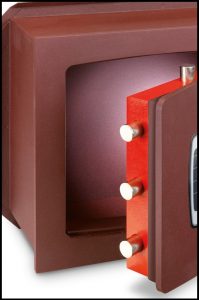In this blog we propose solutions to some of the most common drawbacks which users in possession of electronic safes of various brands tend to face. Thanks to the requests of our users, we can provide a small useful guide which can be consulted by all those who are in the same situation at the moment or in the future. In this blog we have already talked about how to open a safe if the batteries are flat, if there are no external contacts and the emergency key has been lost.
Listed below are other common cases and their respective solutions:
1. THE EMERGENCY KEY HAS BROKEN IN THE LOCKTHE EMERGENCY KEY HAS BROKEN IN THE LOCK
This is a fairly rare occurrence in an electronic safe, but if it does occur it should be treated like similar cases which occur in other types of locks, so reference should be made to this blog.
2. THE BATTERIES HAVE RUN OUT AND THE SAFE HAS REMAINED OPEN WITH THE LOCK BLOCKED

Some users have presented this problem to us. In this case, it will be sufficient to change the batteries, which are generally located inside the door, and enter the code to release the lock. If it does not unlock, we suggest contacting the support team.
3. THERE ARE ACOUSTIC SIGNALS, THE LIGHT IS FLASHING AND THE KEYPAD DOES NOT RESPOND
If you have already ascertained that the batteries are charged and the problems persist, it is likely that the electronic card or the keypad of the safe is damaged. In these cases, it is advisable to contact the support team of the parent company to find the best solution and if necessary replace the component which caused the malfunction.
Also in this case it must be emphasised that, whilst the good quality safes are designed and manufactured to be easily repaired by replacing only the components which could wear over time, the less expensive imported models, when they have an operating problem, generally require the replacement of the entire safe, which is a particularly inconvenient and costly operation in the case of built-in wall versions.
For any other operating defect, we suggest you contact the manufacturer’s support team, as each model has its own particular features.
To conclude, we propose some important suggestions to avoid problems:
- Resist the natural tendency to throw away the installation notes supplied with the safe, even years after its purchase. In fact, as previously stated, as well as allowing you to always have at hand the model of the safe purchased, the installation notes of some models have an additional code that allows the duplication of the emergency key.
- Keep the emergency key in a safe place, possibly not close to the safe (for example, at a relative’s home or office) to prevent any thieves from finding it and never inside the safe,as otherwise it would be useless in an emergency.
- If there is no other solution than to force the safe, always contact the manufacturer’s support service or a professional expert.
- Do not forget the code of the safe or, if necessary, record it in a way only recognisable by the legitimate owners, as suggested by one of our users.
If you are interested in knowing how to correctly install a security safe, how to recognise a good quality one or something else about the world of safes, visit our webpage on the subject.
